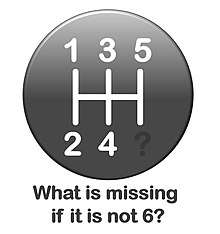Thinking outside the box
Thinking outside the box (also thinking out of the box[1][2] or thinking beyond the box and, especially in Australia, thinking outside the square[3]) is a metaphor that means to think differently, unconventionally, or from a new perspective. This phrase often refers to novel or creative thinking. The term is thought to derive from management consultants in the 1970s and 1980s challenging their clients to solve the "nine dots" puzzle, whose solution requires some lateral thinking.[4] This phrase can also be found commonly in dance, as encouragement to move creatively, beyond simple, geometric box steps and their basic variations, to literally step outside the box into more complex patterns of expression.

| Part of a series on |
| Puzzles |
|---|
 |
The catchphrase (which has become a cliché), is widely used in business environments, especially by management consultants and executive coaches, and has been referenced in a number of advertising slogans. To think outside the box is to look further and to try not thinking of the obvious things, but to try thinking of the things beyond them or even other than them.
Analogy
A simplified definition for paradigm is a habit of reasoning or a conceptual framework.
A simplified analogy is "the box" in the commonly used phrase "thinking outside the box". What is encompassed by the words "inside the box" is analogous with the current, and often unnoticed, assumptions about a situation. Creative thinking acknowledges and rejects the accepted paradigm to come up with new ideas.
Nine dots puzzle
The notion of something outside a perceived "box" is related to a traditional topographical puzzle called the nine dots puzzle.[4]
The origins of the phrase "thinking outside the box" are obscure; but it was popularized in part because of a nine-dot puzzle, which John Adair claims to have introduced in 1969.[5] Management consultant Mike Vance has claimed that the use of the nine-dot puzzle in consultancy circles stems from the corporate culture of the Walt Disney Company, where the puzzle was used in-house.[6]

The nine dots puzzle is much older than the slogan. It appears in Sam Loyd's 1914 Cyclopedia of Puzzles.[7] In the 1951 compilation The Puzzle-Mine: Puzzles Collected from the Works of the Late Henry Ernest Dudeney, the puzzle is attributed to Dudeney himself.[8] Sam Loyd's original formulation of the puzzle[9] entitled it as "Christopher Columbus' egg puzzle." This was an allusion to the story of Egg of Columbus.

The puzzle proposed an intellectual challenge—to connect the dots by drawing four straight, continuous lines that pass through each of the nine dots, and never lifting the pencil from the paper. The conundrum is easily resolved, but only by drawing the lines outside the confines of the square area defined by the nine dots themselves. The phrase "thinking outside the box" is a restatement of the solution strategy. The puzzle only seems difficult because people commonly imagine a boundary around the edge of the dot array.[10] The heart of the matter is the unspecified barrier that people typically perceive.
Telling people to "think outside the box" does not help them think outside the box, at least not with the 9-dot problem.[11] This is due to the distinction between procedural knowledge (implicit or tacit knowledge) and declarative knowledge (book knowledge). For example, a non-verbal cue such as drawing a square outside the 9 dots does allow people to solve the 9-dot problem better than average.[12]
The nine-dot problem is a well-defined problem. It has a clearly stated goal, and all necessary information to solve the problem is included (connect all of the dots using four straight lines, without removing the pen from the paper once you start drawing). Furthermore, well-defined problems have a clear ending (you know when you have reached the solution). Although the solution is "outside the box" and not easy to see at first, once it has been found, it seems obvious. Other examples of well-defined problems are the Tower of Hanoi and the Rubik's Cube.
In contrast, characteristics of ill-defined problems are:
- not clear what the question really is
- not clear how to arrive at a solution
- no idea what the solution looks like
An example of an ill-defined problem is "what is the essence of happiness?" The skills needed to solve this type of problem are the ability to reason and draw inferences, metacognition, and epistemic monitoring.
The single straight line solution
Another well-defined problem for the nine dots starting point is to connect the dots with a single straight line. The solution involves looking outside the two-dimensional sheet of paper on which the nine dots are drawn and coning the paper three-dimensionally aligning the dots along a spiral, thus a single line can be drawn connecting all nine dots - which would appear as three lines in parallel on the paper, when flattened out.[13]
If solving the four line solution is called lateral thinking, then solving the one line solution could well be called orthogonal thinking,[14] as it requires two distinct phases: drawing the line and assembling the line.
The Nine Dots Prize
The Nine Dots Prize is a competition-based prize for "creative thinking that tackles contemporary societal issues."[15] It is sponsored by the Kadas Prize Foundation and supported by the Cambridge University Press and the Centre for Research in the Arts, Social Sciences and Humanities at the University of Cambridge.[16] It was named in reference to the nine-dot problem.[17] Annie Zaidi, an Indian writer won this $100,000 prize on May 29, 2019.[18]
Metaphor

This flexible English phrase is a rhetorical trope with a range of variant applications.
The metaphorical "box" in the phrase "outside the box" may be married with something real and measurable — for example, perceived budgetary[20] or organizational[21] constraints in a Hollywood development project. Speculating beyond its restrictive confines the box can be both:
- (a) positive— fostering creative leaps as in generating wild ideas (the conventional use of the term);[20] and
- (b) negative— penetrating through to the "bottom of the box." James Bandrowski states that this could result in a frank and insightful re-appraisal of a situation, oneself, the organization, etc.
On the other hand, Bandrowski argues that the process of thinking "inside the box" need not be construed in a pejorative sense. It is crucial for accurately parsing and executing a variety of tasks — making decisions, analyzing data, and managing the progress of standard operating procedures, etc.
Hollywood screenwriter Ira Steven Behr appropriated this concept to inform plot and character in the context of a television series. Behr imagined a core character:
He is going to be "thinking outside the box," you know, and usually when we use that cliche, we think outside the box means a new thought. So we can situate ourselves back in the box, but in a somewhat better position.[21]
The phrase can be used as a shorthand way to describe speculation about what happens next in a multi-stage design thinking process.[21]
Sherlock Holmes reference
An older reference to thinking outside the box appears in Sir Arthur Conan Doyle's, The Hound of The Baskervilles. In chapter 3, "The Problem", Holmes is telling Watson under what circumstances that he thinks best: "...It is a singular thing, but I find that a concentrated atmosphere helps a concentration of thought. I have not pushed it to the length of getting into a box to think, but that is the logical outcome of my convictions..."
One interpretation can be framed as a reaction to criticism (and off-base imitation) of Holmes since Doyle had killed him off in the previous novel five years earlier. Holmes is not a purely logical machine, simply running algorithms to deduce answers. But rather, he uses abductive reasoning to find creative solutions. His "outside the box" solutions, (and more than a little luck) account for his high rate of success.
See also
References
- "box - definition of box in English - Oxford Dictionaries". Retrieved 21 November 2016.
- "think outside the box - Definition, meaning & more - Collins Dictionary". Retrieved 21 November 2016.
- "Thinking Outside The Square". Retrieved 21 November 2016.
- Kihn, Martin. "'Outside the Box': the Inside Story," FastCompany 1995
- Adair, John (2007). The art of creative thinking how to be innovative and develop great ideas. London Philadelphia: Kogan Page. p. 127. ISBN 9780749452186.
- Biography of Mike Vance at Creative Thinking Association of America.
- Sam Loyd, Cyclopedia of Puzzles. (The Lamb Publishing Company, 1914)
- J. Travers, The Puzzle-Mine: Puzzles Collected from the Works of the Late Henry Ernest Dudeney. (Thos. Nelson, 1951)
- Facsimile from Cyclopedia of Puzzles - Columbus's Egg Puzzle is on right-hand page
- Daniel Kies, "English Composition 2: Assumptions: Puzzle of the Nine Dots", retr. Jun. 28, 2009.
- Maier, Norman R. F.; Casselman, Gertrude G. (1 February 1970). "Locating the Difficulty in Insight Problems: Individual and Sex Differences". Psychological Reports. 26 (1): 103–117. doi:10.2466/pr0.1970.26.1.103.
- Lung, Ching-tung; Dominowski, Roger L. (1 January 1985). "Effects of strategy instructions and practice on nine-dot problem solving". Journal of Experimental Psychology: Learning, Memory, and Cognition. 11 (4): 804–811. doi:10.1037/0278-7393.11.1-4.804.
- W. Neville Holmes, Fashioning a Foundation for the Computing Profession, July 2000
- Curtis Ogden, Orthogonal Thinking & Doing, 25 September 2015
- "Home". The Nine Dots Prize. Kadas Prize Foundation. Retrieved 19 November 2018.
- "Nine Dots Prize". CRASSH. The University of Cambridge. Retrieved 19 November 2018.
- "The Nine Dots Prize Identity". Rudd Studio. Retrieved 19 November 2018.
- India, Press Trust of (2019-05-29). "Indian writer Annie Zaidi is 2019 winner of the $100,000 Nine Dots Prize". Business Standard India. Retrieved 2019-05-29.
- "Thinking Outside The Box". A+Click.
- Lupick, Travis. "Clone Wars proved a galactic task for production team." The Georgia Straight, August 21, 2008; "... budgetary constraints forced the production team to think outside the box in a positive way.
- "TCA Tour – You Asked For It: Ira Steven Behr's opening remarks". Retrieved 21 November 2016.
Further reading
- Adams, J. L. (1979). Conceptual Blockbusting: A Guide to Better Ideas. New York: W. W. Norton. ISBN 978-0-201-10089-1. ISBN 0-201-10089-4 (more solutions to the nine dots problem - with less than 4 lines!)
- Scheerer, M. (1972). "Problem-solving". Scientific American. 208 (4): 118–128.
- Golomb, Solom W.; Selfridge, John L. (1970). "Unicursal polygonal paths and other graphs on point lattices". Pi Mu Epsilon Journal. 5: 107–117. MR 0268063.
External links
| Look up outside the box in Wiktionary, the free dictionary. |
- Out-of-the-box vs. outside the box citing Oxford Advanced Learners Dictionary (OALD), Word of the Month